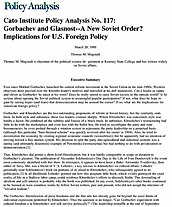Gorbachev and Khrushchev are the two outstanding proponents of reform in Soviet history, but the similarity ends there. In both style and substance, these two leaders contrast sharply. Where Khrushchev was concerned, style was hardly a factor. He exhibited all the subtlety and finesse of a Mack truck. In substance, Khrushchev’s restructuring had little to do with the marketplace and even less with the ballot box. He tried to reconfigure the party and state bureaucracies; he even pushed through a rotation system to rejuvenate the party leadership on a perpetual basis (although this particular “hare-brained scheme” was quickly reversed after his ouster in 1964). Also, he tried to decentralize the economy by creating regional economic councils (sovnarkhozi), but he apparently had no intention of moving toward a free-market system. His decision to split the party into agricultural and industrial sections was a daring (and ultimately disastrous) example of Perestroika (restructuring) but had nothing to do with privatization or democratization.[1]
True, Khrushchev did permit a short-lived liberalization, but it was hardly comparable in scope or duration to Gorbachev’s glasnost. The publication of Alexander Solzhenitsyn’s One Day in the Life of Ivan Denisovich is the event most commonly identified with this thaw. In retrospect, it appears to have been a fluke: Alexander Tvardovsky, then editor of Novy Mir, was a friend of V. S. Lebedev, a key adviser to Khrushchev on cultural affairs. Lebedev personally read Solzhenitsyn’s book (or portions of it) aloud to Khrushchev, who subsequently agreed to its publication.[2] In all likelihood, Lebedev pointed out how this poignant little book, which vividly portrayed the cruel reality of life in a Stalinist labor camp, could reinforce Khrushchev’s efforts to discredit Stalin. This dovetailing of idealism and self-interest is probably why the book was published. In any event, Solzhenitsyn’s other books continued to be banned as were countless works by fellow Soviet writers, past and present, who did not accept the strictures of “socialist realism.”
The Gorbachev liberalization of press freedoms and the fine arts has already gone far beyond the outer limits of individual expression permitted by Khrushchev. Thus the question is no longer, “Can Gorbachev experiment with cultural freedom a la Khrushchev and still survive politically?” (The leadership reshuffle at the end of September 1988, discussed later, is a clear indication that he is neither wavering nor losing his grip.) Indeed, the changes Gorbachev has wrought to date make previous dalliances with cultural experimentation pale by comparison, and yet he remains firmly in control, as the extraordinary party conference in late June 1988 clearly demonstrated. Khrushchev’s “thaw” was, at best, skin deep; Gorbachev’s appears to go to the very heart of the system.

